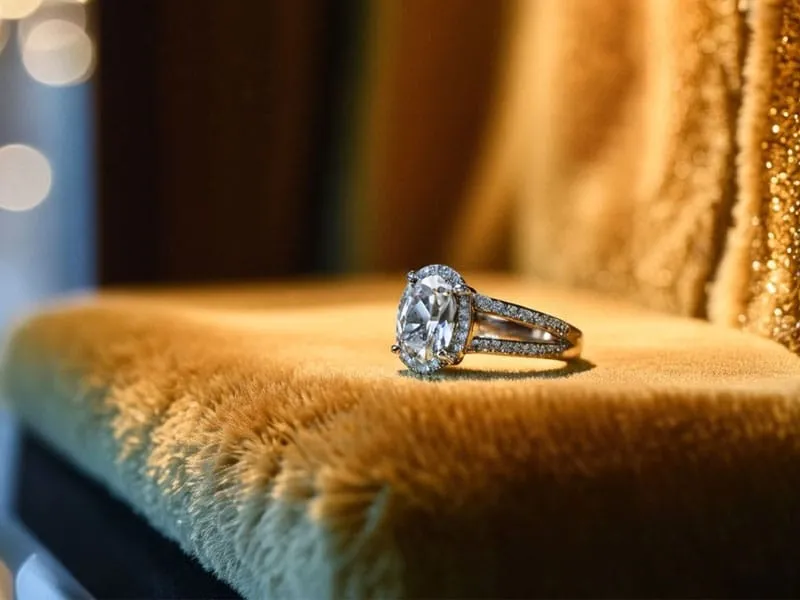
The Ultimate Comparison: Platinum vs. White Gold Engagement Rings
Picking between platinum and white gold for your engagement ring can feel like a big task.
Did you know that both metals are popular but very different?
This article will guide you in finding the right metal that fits your style, needs, and budget.
Let’s find your match!
Key Takeaways
- Platinum is rare, strong, and hypoallergenic, making it a good choice for people with sensitive skin. It stays white forever without needing extra care.
- White gold is less expensive than platinum and offers a sleek shine with rhodium plating. It’s ideal for budget-conscious buyers who still want a precious metal.
- Both metals require some maintenance; platinum needs occasional polishing to maintain its luster, while white gold requires replating to keep its bright white appearance.
- Consider your lifestyle and personal style when choosing between the two; platinum suits active lives better due to its durability, whereas white gold is lighter and might suit less demanding daily activities.
- Price plays a big role in the decision; platinum has a higher initial cost but needs fewer touch-ups over time, potentially making it more economical in the long run for some buyers.
Understanding Platinum and White Gold
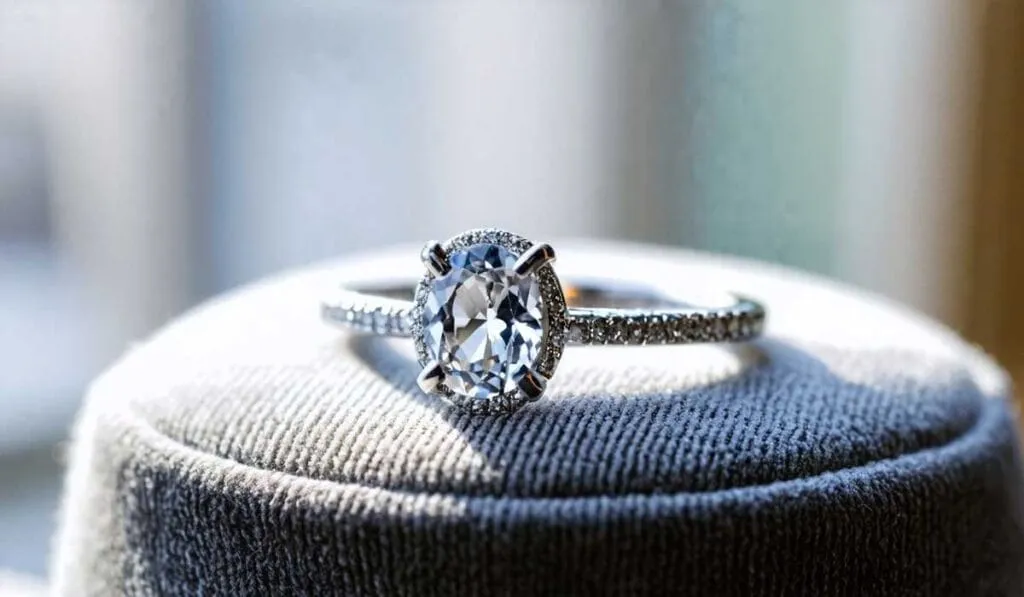
Exploring platinum and white gold is like opening a treasure chest. You’ll find, platinum is a rare metal, shining bright and strong. White gold? That’s gold mixed with metals like palladium or silver to give it that cool shine.
Plus, if your skin says “no thank you” to nickel, white gold rings often come without it to keep things smooth between you and your bling.
Composition and Material Properties
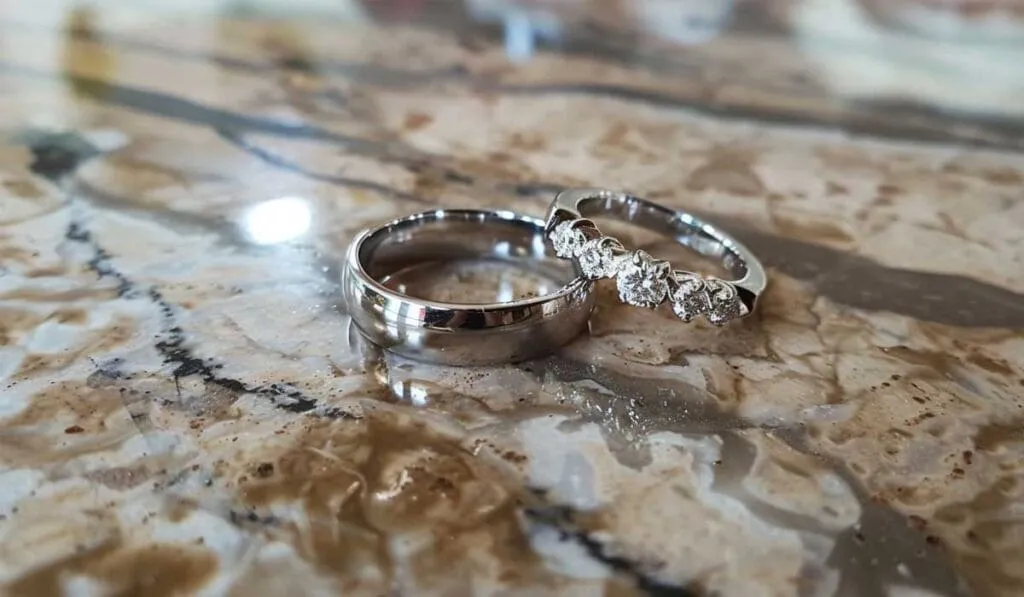
Platinum is a precious metal that stands tall on its own, with no need for mixing with others to maintain its color or shine. Jewelry makers love it because it’s naturally white and doesn’t fade or tarnish over time.
Imagine having a ring that keeps its cool, lustrous look forever without needing extra help.
White gold, on the other hand, is gold playing dress-up. Since pure gold is too soft for everyday wear, it gets mixed with metals like copper and nickel to bulk up its strength. But here’s the twist – white gold isn’t naturally white.
It wears a coat of rhodium plating to get that sleek silver look everyone adores. Think of it as getting ready for a fancy event; without the rhodium makeup, its golden roots start showing.
Gold alloy makes white gold affordable yet stylish – offering a middle ground for those who love the prestige of precious metals without breaking the bank…
Now, let’s talk about how these choices stand up to daily life in our next section: “Hypoallergenic Properties.
Hypoallergenic Properties
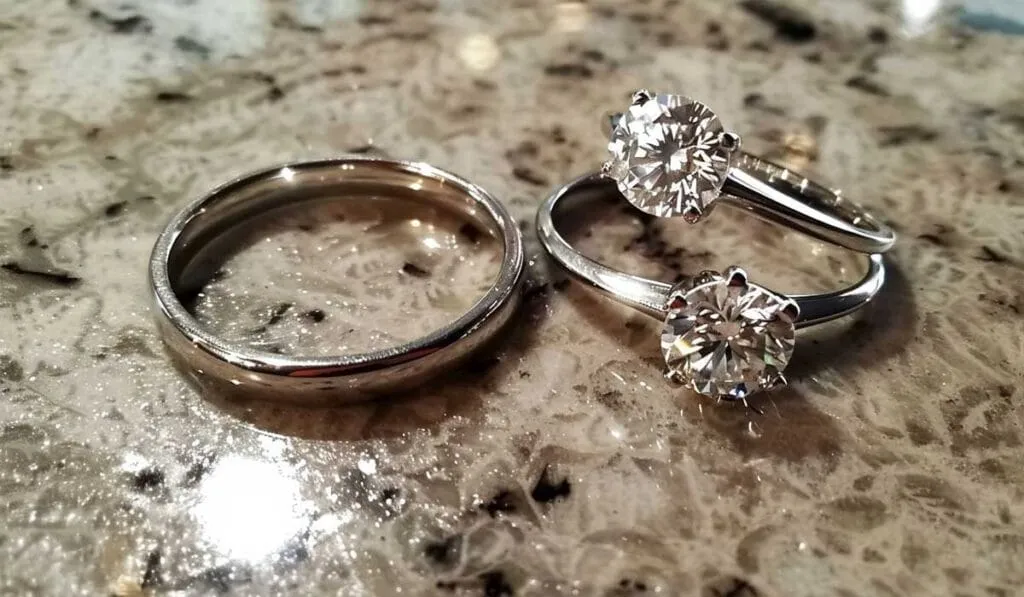
Jumping from what these metals are made of, let’s talk about something equally important—how they treat your skin. You might love a ring’s look, but if wearing it turns your finger green or causes an itch, that’s a big no-no.
Here’s where hypoallergenic properties come into play like a knight in shining armor for sensitive skin.
White gold often contains nickel—a common allergen that can lead to discomfort for some people.
On the flip side, platinum is like that friend who never lets you down. It’s naturally hypoallergenic, making it a safe bet for anyone worried about allergic reactions.
Think of it as your skin’s BFF, always keeping things cool and comfortable under those beautiful gems.
If you have a nickel allergy or just want to play it safe, favoring platinum could save the day—and your skin.
Letting your heart (and skin) feel at ease makes choosing between white gold and platinum not just about beauty but comfort too.
Comparison of Platinum and White Gold
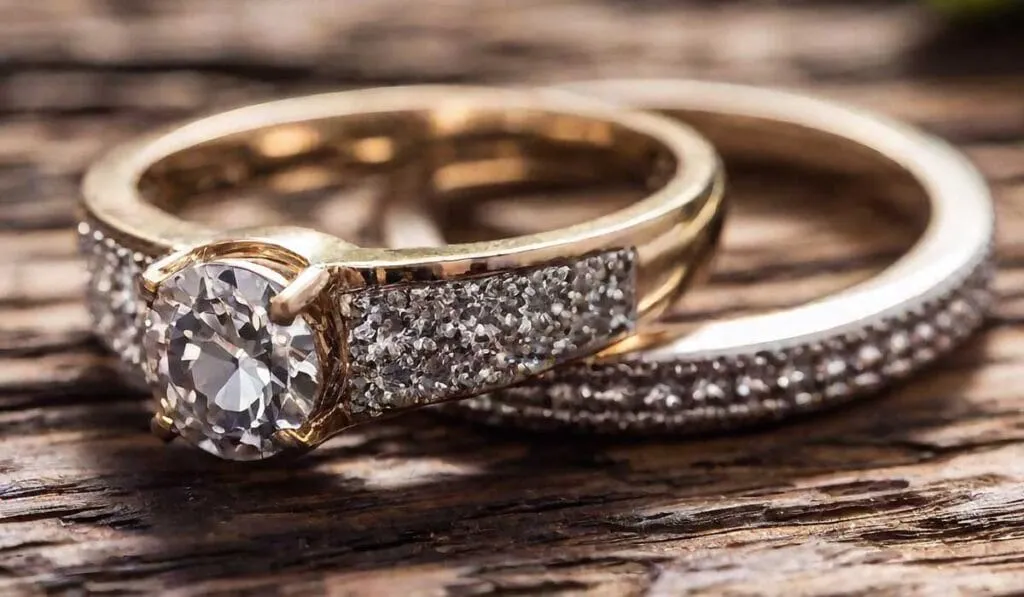
When it’s time to pick out your dream engagement circle, choosing between platinum and white gold can feel like a big deal. Let’s shine a light on how they stack up against each other.
Color Differences
Platinum shines with a natural, white sheen that holds its color forever. Think of it like the glow of moonlight — gentle yet captivating. This metal doesn’t need rhodium plating to keep its luster, making it stand out in its pure glory among engagement rings and wedding bands.
On the flip side, white gold boasts a reflective shine that rivals bright sunlight bouncing off snow. It’s not naturally white though; jewelers mix it with alloys and coat it with rhodium for that silver-like appearance.
Over time, this coating may wear down, requiring a quick trip to your jeweler for a touch-up to bring back its sparkle.
Choosing between these metals? Imagine how they’ll look holding a gemstone. Platinum’s durability makes any gem pop without overshadowing its brilliance — like stars against the night sky…
While white gold frames diamonds beautifully, enhancing their clarity grade and diamond color as if under a spotlight.
Each has its stage where it shines brightest; platinum wins longevity while white gold takes the prize for instant dazzle-factor — just something to think about while you’re on your quest for the perfect ring.
Durability and Maintenance
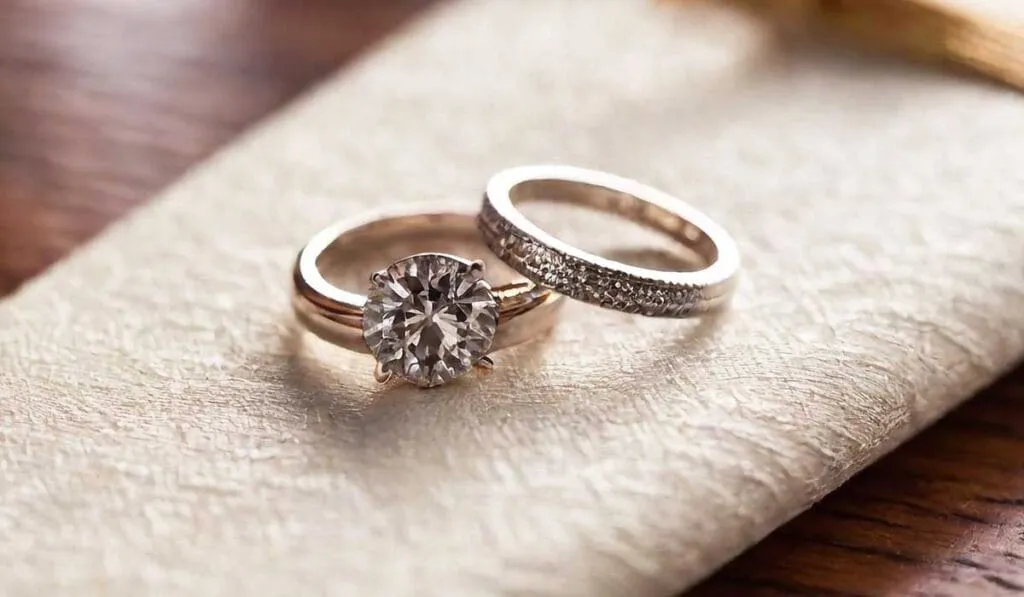
Shifting gears from hues to toughness, let’s talk about how well these metals can take a day-to-day beating. You’ve got dishes to wash, work to do, and life doesn’t stop just because there’s a fancy ring on your finger.
Platinum is strong and dense. It can endure all the knocks of daily activities without much fuss. Unlike its counterpart, it develops a natural patina over time, which many adore for that vintage vibe.
Now, white gold isn’t a pushover in the durability department either. However, it has a sidekick called rhodium plating that needs refreshing now and then to keep its shine bright like a diamond clarity that catches the eye.
Think of it as needing a spa day; every once in awhile, your ring will too. And when those spa days come around—whether for buffing out scratches or replating—it’s back to looking stunning.
Caring for these metals isn’t rocket science but does require some attention. For platinum rings, occasional dishwashing won’t harm them but skipping on harsh chemicals is wise advice.
White gold fans should note: lotions and potions might speed up visits for rhodium touch-ups.
Both demand gentle cleaning with mild soap and water—a simple yet effective method to maintain their lustre without visiting professional jewellers too frequently.
Price Comparison
Let’s talk about the price tag. You’re balancing your budget, dreaming of the perfect ring.
Here’s a breakdown that won’t make your head spin.
| Aspect | Platinum | White Gold |
|---|---|---|
| Initial Cost | Generally higher | More affordable |
| Long-term Maintenance | Less frequent polishing and refinishing | Requires rhodium plating every few years |
| Price Stability | More stable, less affected by market changes | Can vary with gold market fluctuations |
| Overall Value | Higher resale value | Lower resale value but high initial value for money |
Now, platinum might make your wallet a bit lighter at the start. But hey, it’s like buying a luxury car that holds its value.
On the flip side, white gold is like a stylish, reliable sedan. It’s easier on your bank account now and looks just as shiny.
Each has its charm, right? So, pick the one that matches your love story and budget.
Advantages and Disadvantages
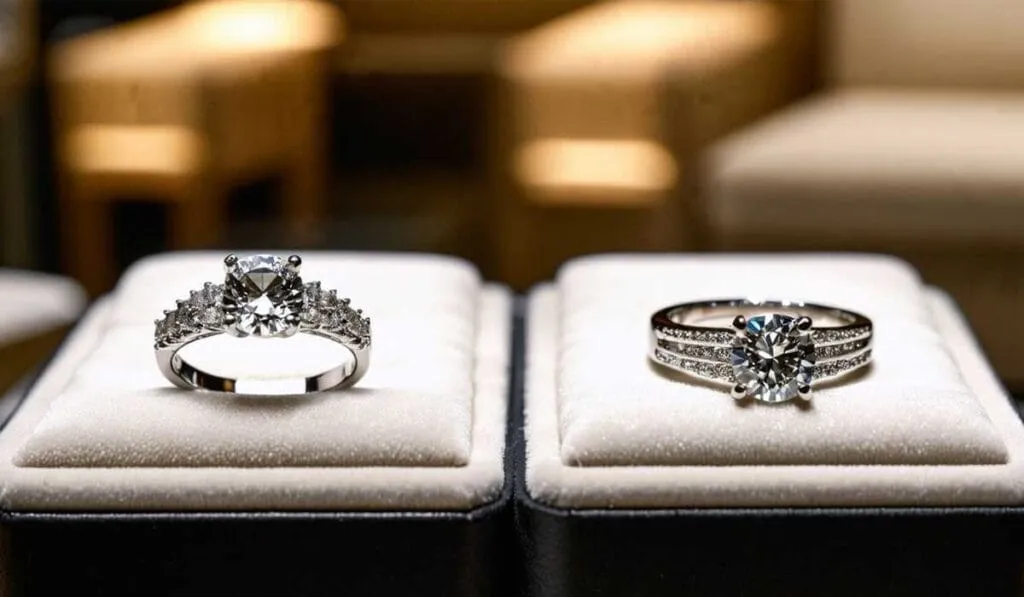
Picking between platinum and white gold feels like choosing your favorite ice cream flavor—both are amazing, but they bring their own zest to the table. Platinum shouts luxury with its heft and rarity, while white gold whispers elegance and offers a lighter touch on your wallet.
Why Choose Platinum?
Platinum is like the superhero of metals. It’s strong, durable, and can take a lot of knocks without showing wear. Unlike its cousin, white gold, platinum doesn’t fade or change color over time.
Think about it as the “forever” metal for your forever ring! Plus, if you have sensitive skin, here’s good news: platinum is hypoallergenic. That means no itching or redness where your ring sits.
Choosing platinum says you’re all in for both luxury and practicality. Sure, it might cost a bit more upfront compared to white gold—but think of it as an investment in something that will stand the test of time.
Your wedding ring isn’t just any piece of jewelry; it’s a symbol of love that lasts a lifetime. Don’t overpay for it at a big box store. And with platinum’s natural white sheen enhancing the sparkle and brilliance of diamonds—it’s like this metal was made for moments that matter most.
Why Choose White Gold?
White gold shines with a sleek and modern vibe, capturing hearts left and right. Think about it—white gold jewelry brings together the class of gold and the cool undertone of silver into one stunning package.
It’s like getting the best of both worlds! Plus, if you’re worried about allergies, breathe easy. White gold often comes as hypoallergic, thanks to its nickel-free alloys, making your ring not just beautiful but also comfortable for everyday wear.
Let’s talk dollars and sense. Going for white gold over platinum can keep some cash in your pocket without compromising on style or quality.
And here’s a pro tip: white gold rings require little more than regular cleaning to keep their luster shining bright year after year.
So, whether you’re hitting the gym or typing away at work, your ring will stand by you through thick and thin.
Now that we’ve got you glowing about white gold let’s shift gears and look into matching those metals with gemstones…
Considerations for Choosing Your Ring Metal
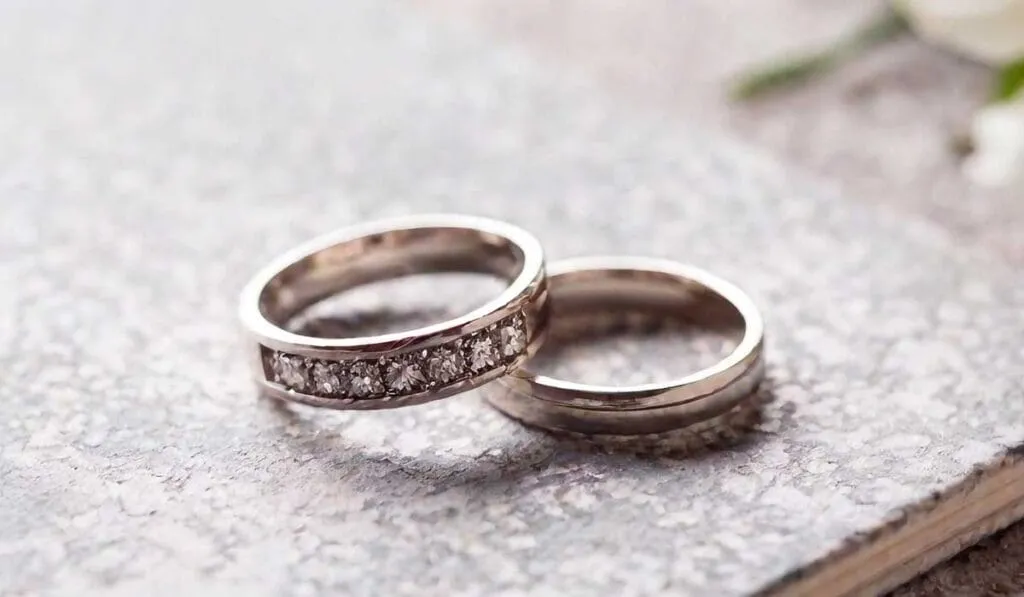
Picking your ring metal isn’t just about looks. It’s like choosing a teammate for life.
Matching Metals with Gemstones
Choosing the right metal for your ring is like picking the perfect teammate for a gem. Think of platinum or white gold as players in a game where the goal is to make that sparkling stone on your finger shine its brightest.
If you’re eyeing a diamond, both metals are fantastic picks because they bring out the brilliance and fire of diamonds without stealing the show. But, let’s not forget about colored stones—platinum’s cool tone beautifully complements vibrant gems like sapphires and rubies, giving them a royal backdrop.
On the flip side, white gold has this magical way of enhancing softer-colored gems such as pink quartz or moonstone by adding just enough contrast to make them pop.
It’s all about finding harmony between metal and gem so they can perform their best duet on your finger.
Imagine pairing your favorite tunes with just the right musical accompaniment—that’s what matching metals with gemstones feels like.
A soft melody might pair well with gentle piano notes while a powerful ballad calls for full orchestra backing.
Similarly, choosing between platinum and white gold depends on what kind of visual symphony you want to create with your engagement ring.
Consider lifestyle too—platinum holds up well against everyday wear whereas white gold requires more care but rewards you with an exquisite sheen that dances under any light.
So take a moment, think about what colors sing to you from those shiny rocks at the jewelry store, and choose a metal that elevates their beauty even further.
Lifestyle and Everyday Wear
Your lifestyle plays a big role in which ring metal you should pick. If your day-to-day includes lots of activity, hands-on work, or exposure to chemicals, consider this: platinum stands up to scratches and wear way better than white gold.
Plus, if you’re always on the move, a low-maintenance option might be just what you need.
On the flip side, if your daily grind isn’t quite so demanding on your hands, white gold could be a win for you. It’s lighter on the finger and easier on the wallet. Think about it—no worrying over every little ding or scratch when typing away at an office desk or attending social events.
Just keep in mind that white gold needs a dip in rhodium plating now and then to keep its shine bright. Your choice depends on how much sparkle you want but also how ready you are to look after it.
Personal Aesthetic Preferences
After considering how your ring will fit into your daily life, it’s time to explore what really tickles your fancy—your personal style. Think of this as the cherry on top.
Does the cool luster of white gold call to you, or does platinum’s rich patina make your heart skip a beat?
Each metal brings its own flavor to the table.
Platinum, dense and durable, grows more beautiful with age, developing a sought-after finish that tells a story of love over time. White gold, on the other hand, shimmers bright and requires a little TLC to keep its rhodium coating sparkling.
Choosing between these two metals isn’t just about their looks; it reflects who you are. Are you someone who appreciates the strength and longevity symbolized by platinum?
Or do you lean towards the affordable elegance that white gold offers? There’s no wrong choice here—just what feels right for you.
Color plays a huge role in this decision too. While both metals are stunning in their own right with gemstones adorning them—the contrast against rose gold or yellow gold can indeed set apart one’s preference.
In essence, deciding on platinum versus white for an engagement ring boils down to what sings to your individual taste while aligning with how you live each day.
Keep in mind those special occasions when your ring needs to shine brightest alongside other pieces like gold jewelry or sterling silver accessories—making sure they complement rather than clash could be key!
Popular Engagement Ring Settings for Each Metal

Whether you lean towards shiny platinum or elegant white gold, each metal makes certain engagement ring designs stand out.
Platinum is a hit with sleek, modern looks while white gold complements both classic and contemporary styles.
Favorite Platinum Settings
Platinum shines bright in engagement rings. Its durability and sleek look make it a top pick for those special moments.
- Solitaire Setting: A single diamond sits atop a platinum band, showcasing its brilliance. The simplicity of this setting allows the gemstone to be the star of the show. It’s perfect if you love elegance that stands the test of time.
- Halo Setting: This features a center stone surrounded by smaller diamonds, enhancing its sparkle. Platinum’s strength supports the intricate design, making your ring a dazzling piece of art.
- Three-Stone Setting: Symbolizing your past, present, and future, this setting uses three stones to tell your story. Platinum’s natural white luster complements any gemstone color, ensuring each stone pops.
- Pave Setting: Tiny diamonds pave the band, leading up to the center gemstone, creating a path of light. This setting in platinum adds an extra layer of shine, as its hypoallergenic properties keep your ring looking new longer.
- Bezel Setting: A metal rim encases the perimeter of the gemstone, securing it in place. For active lifestyles, this platinum setting offers protection and style without compromising on luxury.
- Vintage Settings: Intricate details like milgrain or filigree work are standout features in vintage-style rings. Platinum is ideal for crafting these delicate designs while providing a sturdy foundation that keeps every detail sharp over decades.
- Antique designs often demand metals that can hold fine engravings and withstand polishing without losing charm; platinum is unmatched in preserving these features.
- Split Shank Setting: The band splits as it nears the center stone, adding interest and dimension to your ring’s design. With platinum’s malleability, jewelers can create unique split shank designs that are as durable as they are beautiful.
Choosing platinum means investing in a lifetime of memories with a ring that lasts as long as your love does. Its unmatched durability paired with timeless styles makes it clear why so many opt for platinum settings for their engagement rings.
Favorite White Gold Settings
White gold has a magic all its own, especially in the glow of engagement rings. Its luster complements diamonds and other gemstones beautifully, making each setting a work of art. Here are some favorite white gold settings that might just capture your heart and imagination:
- Solitaire Setting: Classic and timeless, the solitaire setting showcases a single diamond or gemstone. The simplicity of white gold enhances the stone’s brilliance without stealing the spotlight. This setting is perfect for someone who loves elegance and a touch of tradition.
- Pave Setting: If sparkle is your thing, then pave settings in white gold are your best friend. Small diamonds are set closely together along the band, creating a dazzling effect that looks like the ring is paved with glittering stones.
- Halo Setting: A halo of smaller diamonds encircles the main stone, making it appear larger and more luminous. White gold’s sleekness makes this setting appear even more ethereal, ideal for those who dream big.
- Three-Stone Setting: Representing past, present, and future, this symbolic setting features a central stone flanked by two others. White gold enhances the meaning behind each stone’s placement and adds to the overall allure.
- Twisted/Vine Setting: For those who love nature or unique designs, twisted or vine settings create an organic look with white gold metal intertwined around the central stone. It’s whimsical yet sophisticated—a true conversation starter.
- Bezel Setting: In this secure setting, a thin rim of white gold encases the gemstone completely or partially. It’s modern and sleek but also practical for those with active lifestyles since it protects the stone well.
- Voltage-setting: Adding a contemporary twist to traditional designs; voltage settings use tension to hold the center stone in place between two ends of white gold band giving an illusion that gemstone is floating which is both mesmerizing and innovative.
- Split-shank Setting; A split-shank band divides into two as it approaches center sumptuous giving wearer room for more creative design embellishments This type design complements bold personalities seeking statement pieces
Each setting uniquely celebrates love story choosing right one depends on personal style lifestyle comfort Now let’s dive into care cleaning tips ensuring these beautiful rings last lifetime
Care and Cleaning
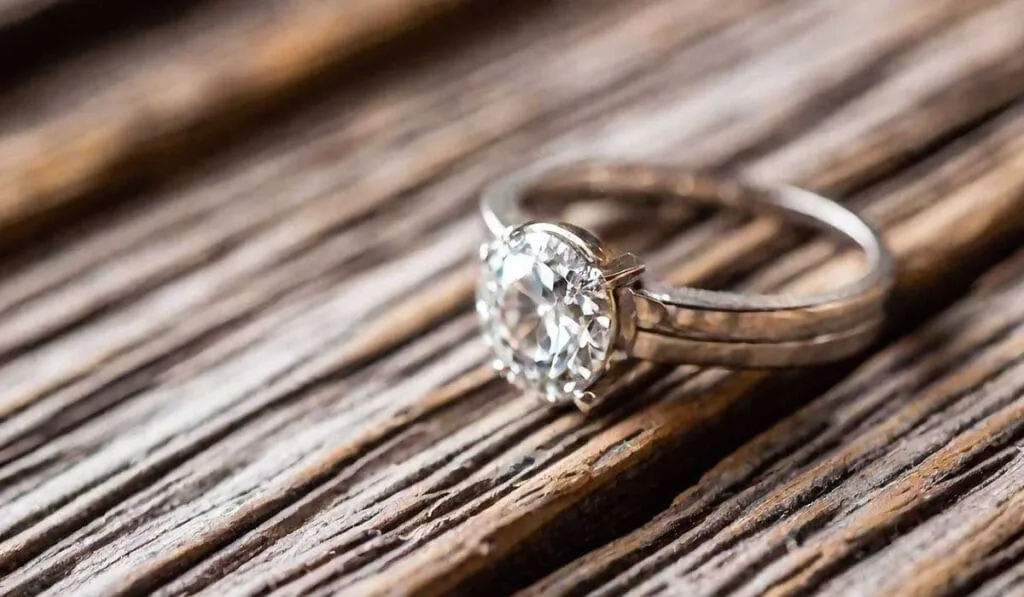
Keep your ring looking shiny and new with easy care tips. Whether it’s platinum or white gold, we’ve got the secrets to make it sparkle. Dive in to learn more!
Tips for Maintaining Platinum Rings
Taking care of your platinum ring ensures it shines for years. This durable metal from the platinum group needs a little love to maintain its luster. Here’s how:
- Clean with gentle soap and warm water regularly. A mild dish washing liquid works well to remove everyday dirt.
- Use a soft-bristled brush, like a toothbrush, for cleaning hard-to-reach places. This helps get rid of any grime stuck in the crevices without scratching the surface.
- Dry your ring with a lint-free cloth after washing. It prevents water spots and keeps the metal looking shiny.
- Store your platinum ring separately. Use a fabric-lined jewelry box or pouch to avoid scratches from other pieces.
- Take off your ring during heavy work or when using harsh chemicals. Even though platinum is tough, it’s better safe than sorry.
- Visit a graduate gemologist for annual check-ups… They can spot any wear and tear you might miss.
- Polish your ring once a year at a jeweler certified by the Gemological Institute of America (GIA). They use professional tools and techniques that ensure your ring looks its best without harming it.
- Look out for tarnish – platinum can develop patina over time, which some people love for its antique look! If that’s not your style, a jeweler can polish it back to its original gloss.
Caring for platinum isn’t rocket science, but these simple steps go a long way in keeping your engagement ring as dazzling as the day you got it!
Tips for Maintaining White Gold Rings
Taking care of your white gold ring keeps it shiny and new-looking. This metal, popular for engagement rings, requires some special attention to stay beautiful. Here’s how you can ensure your ring remains as dazzling as the day you said “yes”:
- Clean regularly with mild soap and water. A soft brush can remove dirt stuck in crevices.
- Dry your ring thoroughly after washing to prevent water spots or residue.
- Keep it away from harsh chemicals like chlorine and bleach, which can damage gold jewellery.
- Store your white gold separately in a soft cloth bag to avoid scratches from other pieces of jewelry.
- Have a professional jeweler check your ring annually for loose stones or potential damage.
- Replate your white gold ring every few years to maintain its bright luster; the rhodium plating wears off over time.
- Avoid wearing your ring during heavy manual work or when using abrasive materials that could scratch it.
- Use a polishing cloth specifically designed for gold jewellery to buff away minor scratches.
Caring for white gold isn’t hard, but it does require some regular upkeep to keep its sparkle. Next, let’s delve into caring for platinum rings – another popular trend for engagement bling!
Conclusion
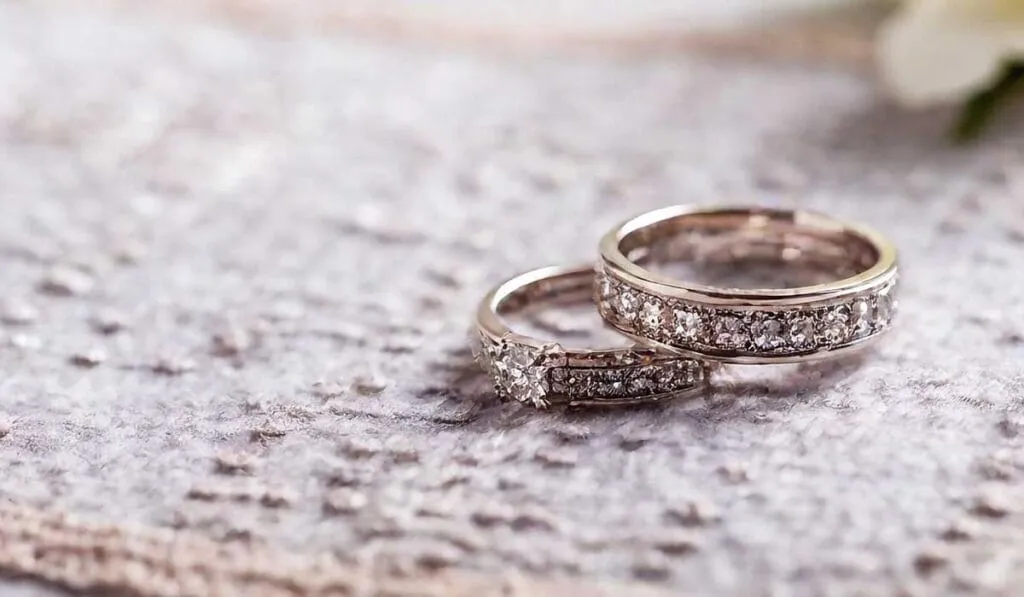
So, you’re on the hunt for that perfect ring metal, eh? Platinum or white gold — both shine bright like a diamond in their own ways. Think of platinum as the sturdy friend who’s always there for you.
It’s strong and doesn’t fade away. On the flip side, white gold is like that stylish buddy who requires a bit extra care to keep its sparkle.
Your choice might boil down to what sings to your heart…and maybe your wallet too. Platinum stands tall with its durability but comes with a heftier price tag.
White gold, however, asks for regular check-ups to maintain its gleam but is easier on the pockets.
This isn’t just any decision; it’s about finding a companion for that precious gemstone—a partner that matches your day-to-day hustle and personal flair.
So take a breath, weigh your options, and trust your gut—you’ve got this!
FAQs
1. What’s the difference between platinum and white gold for an engagement ring?
Platinum is a pure metal that’s naturally white, while white gold is a blend of yellow gold with other metals to achieve its color. Each has their own hallmark of quality.
2. How does the hardness factor into choosing between platinum and white gold?
In terms of hardness, platinum can be more durable than white gold. It’s like comparing apples to oranges – both have their merits!
3. Does carat weight matter when choosing between these two metals?
A diamond’s carat weight won’t change whether it’s set in platinum or white gold; however, some might argue that certain carats look better against one metal over another.
4. Are there any cost differences between platinum and white gold engagement rings?
Yes indeed! Platinum tends to be pricier than its counterpart due to its rarity and higher purity level.




